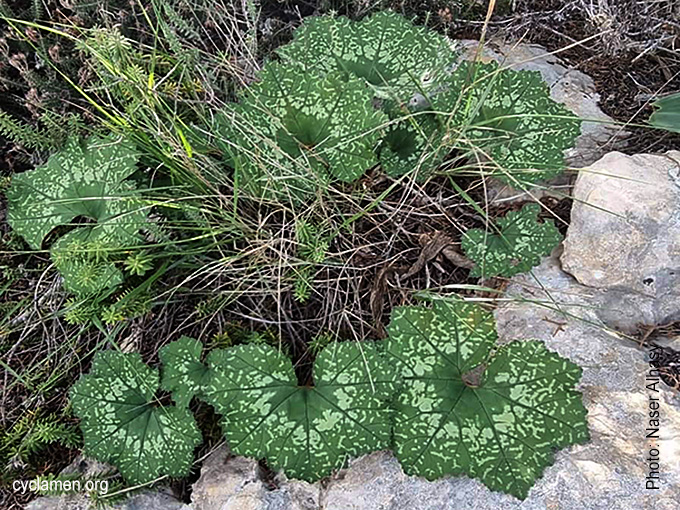Description
Flowers appear in autumn, in the wild from September to November, dependent on the start of the autumn rains, in shades of pink, scented. The corolla lobes are reflexed, 10-25mm long, 6-9mm wide, generally with 180 degrees twist, auricles at the base and a darker pink area at the nose of the flower. The stamen cone is clearly visible, protruding from the nose of the flower, which is unique to this species. Unusually among cyclamen, after fertilisation the flower stalk begins to coil from the bottom rather than the top as in most species.
Leaves appear during flowering or soon after, dependent on the amount of rain, generally shaped like a maple leaf, often broader than long, with large lobes and toothed edges, varying from plain green to patterned in shades of silvery green on a darker green ground, underside purplish, 4-12cm long, 5-16cm wide.
Tuber
Tuber spherical, becoming very irregular with age, large at maturity, up to 20cm or more in diameter, brown, rough, thick (2mm) diameter branching roots arise from almost anywhere on the surface.
Distribution
Cyclamen rohlfsianum grows in Libya in the Jabal al Akhdar mountain region near the coast of Cyrenaica between Benghazi and Derna.
Habitat
Cyclamen rohlfsianum grows under a typically Mediterranean climate with hot dry summers and warm wet winters, from sea level to 450m, under scrub and in open woodland, in terra rossa over limestone, often among rocks or in crevices.
A superb gallery of wild plants and
habitat photographs can be seen here.
Cultivation
Cyclamen rohlfsianum is a tender plant, so best cultivated as a pot plant in a frost-free greenhouse in northwest Europe. Too much water early during growth causes the leaves to develop faster than the flowers and hide them. A little water from the base during summer seems to help flower bud formation and not giving larger quantities until the flowers are nearly over seems to work well. A pure white form (album) has arisen recently in cultivation (1997).

Cyclamen rohlfsianum forma album
Cyclamen rohlfsianum forma album
A white-flowered variant occurred in cultivation in 1997 in the collection of Susan and Michael Ayling of Kingsly, Hampshire, arising as one of a batch of seedlings of long-cultivated stock. The plant has completely white flowers with no trace of colour around the mouth and was described as C. rohlfsianum forma album by Brian Mathew in the June 2002 issue of the Cyclamen Society’s journal.
To date, only this single plant has been recorded which does not appear to be self-fertile and has as yet, not set viable seed.













